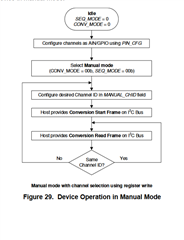Other Parts Discussed in Thread: ADS7038
Hello,
I'm currently writing a driver for this chip, and I'm a bit confused on the sequence of events for manual mode.
On Page 23 it gives the flow chart:

My question concerns when I need to use the op-code and when I do not.
So as I understand, we first configure channels as AI. To do this, I need to send:
Addr + Op-Code + Reg Addr + Value to Set
So for example, here is the general form of that command with 0x08 being the write single register, 0x05 being the address of the PIN_CFG and 0x00 meaning set all to AI
| S | | 7-bit Slave Address | | W | {Ack} | 0x08 | {Ack} | 0x05 | {Ack} |0x00| {Ack} |P|
Then I write the Channel ID I wish to read, so for example for channel 1:
| S | | 7-bit Slave Address | | W | {Ack} | 0x08 | {Ack} | 0x11 | {Ack} |0x01| {Ack} |P|
So then to initiate a conversion, I no longer need the op-code? I'm not actually reading any particular register like RECENT_CH1_LSB?
I send something like this:
| S | | 7-bit Slave Address | | R |
And then wait for a response?
Thanks,



